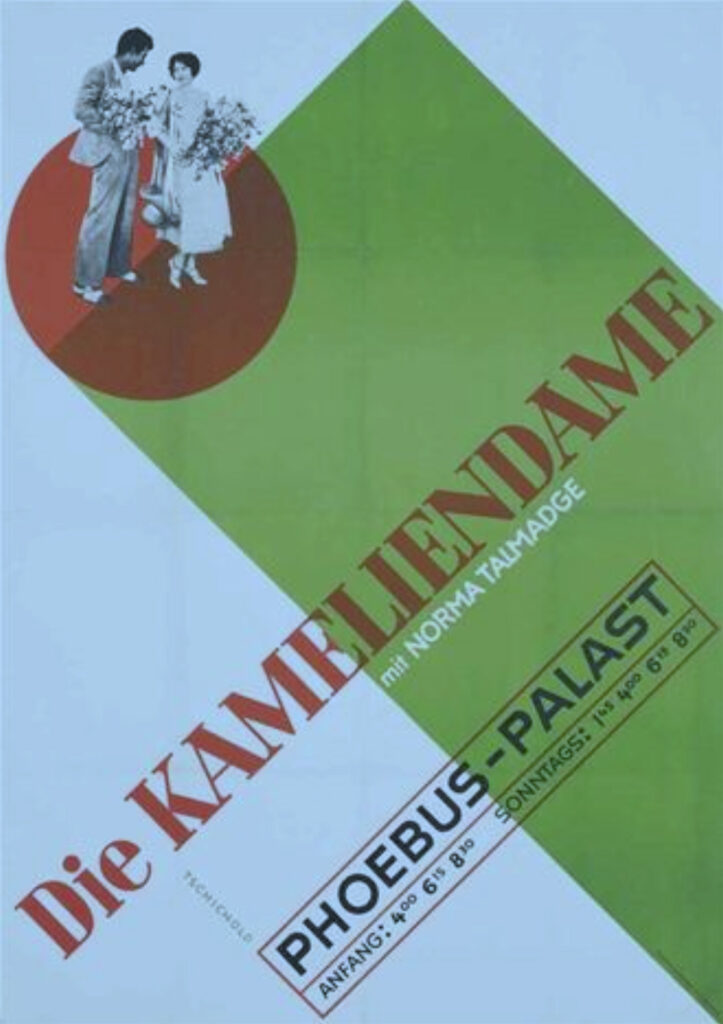22 november 2021
Die Kameliendame (in English the Lady of the Camellias¹) was an influential 19th century novel first published by the author Alexandre Dumas in 1848. Over the years, it has been a source of inspiration for countless ballets, films and operas such as La Traviata of Verdi. This article focuses on the influence it had on a 20th century advertising poster made by the German artist Jan Tschichold for the movie Die Kameliendame by Fred Niblo.
Jan Tschichold and The Neue Typographie
Jan Tschichold was a leading figure of 20th century graphic design and typography, largely influenced by the Bauhaus movement. He was trained as a professional calligrapher at the Leipzig Academy and also learned wood engraving which introduced him to letter spacing. In his most famous manifesto, Die Neue Typographie (Berlin, 1928), he laid down the unifying principles of typography, declaring that it should be informative, but also as dynamic as society and the machine age. He drew inspiration especially from Communist influences, which would result in him being prosecuted by the Nazis, after which he found exile in Switzerland.
His poster, The Lady of the Camellias originally presents the figure of the “fallen woman” and her relationship with prostitution, but in it we don’t see the intention of describing the play in a detailed way, neither the cast names are displayed with simple block texts as they were during the 1910s. It is natural to wonder what is the reason for this.
Movie posters from the 1920s would evolve from ornamentalism to functionalism after the First World War, when several graphic designers started getting inspiration from contemporary movements such as Dada, Futurism, Cubism, De Stijl or Russian Constructivism. These movements aimed to reduce complex elements to basic shapes so that they were effortlessly read by mass audiences, as their purpose was to inspire society with modernism and science, but at the same time entertainment as consumer culture was growing by leaps and bounds.
The aim of his movie poster was to express a clear and concise message using the least number of elements possible, which would also be expressed through the Bauhaus principle of “less is more”. In regards to hierarchy, in the poster we see an asymmetrical layout, which had the purpose to bring a more varied experience to the reader, using the red circle as an attention-grabber that diverts the eye all around the composition instead of driving it from up left to bottom right as in newspapers. The combination of serif and sans-serif fonts with different weights also supported this intention.
In his book Typographische Gestaltung (1935), he introduces the term typo-photo, a notion that integrated photography and typography in the same visual communication to convey a message. The idea was inspired by his fellow photographer Lászlo Moholy-Nagy who understood that typography could be perceived as image and image could be perceived as text, reducing the distinction between them.
The legacy of Tschichold in 20th century graphic design and typography is remarkable, as he reconsidered all the elements that make up a poster, just as an architect or sculpture would do. He also replaced static text boxes by dynamic compositions, giving them tone, rhythm and personality. These simplified elements evoke an interest in the reader, while also keeping the content informative. As Tschichold himself stated, being innovative in typography comes as a challenge, as “we cannot alter the essential shape of a single letter without at the same time destroying the familiar printed face of our language, and thereby rendering it useless“.²

Image 1. Die Kameliendame Phoebus Palast Norma Palast found in The International Advertising & Design Database (IADDB).
¹ Jhonson, Christiana (2016). La Dame aux Camélias’ Effect on Society’s View of The Fallen Woman The Kabod 2 (2 (2016)), Article 7. Retrieved from https://digitalcommons.liberty.edu/cgi/viewcontent.cgi?article=1039&context=kabod
² Tschichold, Jan. (1949 - 1974). The Form of The Book: Essays on the Mora. Pages 21-22. Retrieved October 23, 2021 from https://es.scribd.com/doc/207834525/The-Form-of-the-Book-Essays-on-the-Mora-Jan-Tschichold#download.
D. Berry, John. (2007, Autumn). Faith in asymmetry. Eye Magazine . Retrieved October 23, 2021 from http://www.eyemagazine.com/review/article/faith-in-asymmetry.
Hollis, Richard. (2008, December 5). Jan Tschichold: a titan of typography. The Guardian. Retrieved October 21, 2021 from https://www.theguardian.com/artanddesign/2008/dec/05/jan-tschichold-typography.
F. Le Coultre, Martijn. (January 2007). Jan Tschichold: Posters of the Avant Garde. Pages 9-231. VK Projects, Laren.
The poster collection is made accessible by the collaboration between Design Museum Dedel and Reclame Arsenaal (IADBB). For more such interesting stories subscribe to our blog, follow us on Instagram and maybe visit our museum.
 Rocío Vázquez Varela de Seijas
Rocío Vázquez Varela de Seijas
Rocío is an artist and graphic designer with a special interest in advertising and the psychology of communication. She cherishes to reflect on the way we as a society perceive art, advertising, movies or popular culture. You can reach her at roxiovazquez@gmail.com.
